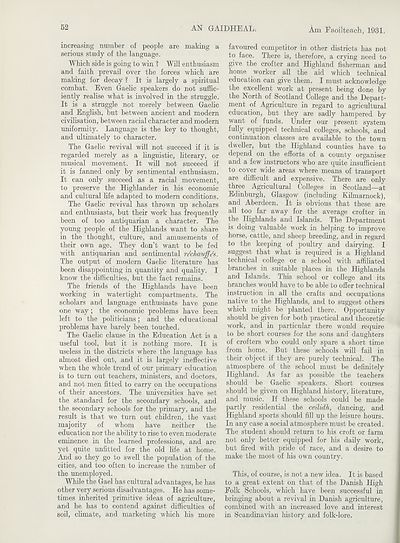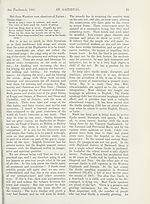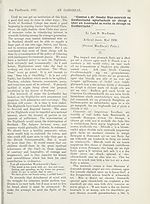An Comunn Gàidhealach Publications > Gaidheal > Volume 26, October 1930--September 1931
(72) Page 52
Download files
Complete book:
Individual page:
Thumbnail gallery: Grid view | List view

52
AN GAIDHEAL:
Am Paoilteach, 1931.
increasing number of people are making a
serious study of the language.
Which side is going to win ? Will enthusiasm
and faith prevail over the forces which are
making for decay ? It is largely a spiritual
combat. Even Gaelic speakers do not suffic¬
iently realise what is involved in the struggle.
It is a struggle not merely between Gaelic
and English, but between ancient and modern
civilisation, between racial character and modern
uniformity. Language is the key to thought,
and ultimately to character.
The Gaelic revival will not succeed if it is
regarded merely as a linguistic, literary, or
musical movement. It will not succeed if
it is fanned only by sentimental enthusiasm.
It can only succeed as a racial movement,
to preserve the Highlander in his economic
and cultural life adapted to modern conditions.
The Gaelic revival has thrown up scholars
and enthusiasts, but their work has frequently
been of too antiquarian a character. The
young people of the Highlands want to share
in the thought, culture, and amusements of
their own age. They don’t want to be fed
with antiquarian and sentimental rechauffes.
The output of modern Gaelic literature has
been disappointing in quantity and quality. I
know the difficulties, but the fact remains.
The friends of the Highlands have been
working in watertight compartments. The
scholars and language enthusiasts have gone
one way; the economic problems have been
left to the politicians; and the educational
problems have barely been touched.
The Gaelic clause in the Education Act is a
useful tool, but it is nothing more. It is
useless in the districts where the language has
almost died out, and it is largely ineffective
when the whole trend of our primary education
is to turn out teachers, ministers, and doctors,
and not men fitted to carry on the occupations
of their ancestors. The universities have set
the standard for the secondary schools, and
the secondary schools for the primary, and the
result is that we turn out children, the vast
majority of whom have neither the
education nor the ability to rise to even moderate
eminence in the learned professions, and are
yet quite unfitted for the old life at home.
And so they go to swell the population of the
cities, and too often to increase the number of
the unemployed.
While the Gael has cultural advantages, he has
other very serious disadvantages. He has some¬
times inherited primitive ideas of agriculture,
and he has to contend against difficulties of
soil, climate, and marketing which his more
favoured competitor in other districts has not
to face. There is, therefore, a crying need to
give the crofter and Highland fisherman and
home worker all the aid which technical
education can give them. I must acknowledge
the excellent work at present being done by
the North of Scotland College and the Depart¬
ment of Agriculture in regard to agricultural
education, but they are sadly hampered by
want of funds. Under our present system
fully equipped technical colleges, schools, and
continuation classes are available to the town
dweller, but the Highland counties have to
depend on the efforts of a county organiser
and a few instructors who are quite insufficient
to cover wide areas where means of transport
are difficult and expensive. There are only
three Agricultural Colleges in Scotland—at
Edinburgh, Glasgow (including Kilmarnock),
and Aberdeen. It is obvious that these are
all too far away for the average crofter in
the Highlands and Islands. The Department
is doing valuable work in helping to improve
horse, cattle, and sheep breeding, and in regard
to the keeping of poultry and dairying. I
suggest that what is required is a Highland
technical college or a school with affiliated
branches in suitable places in the Highlands
and Islands. This school or college and its
branches would have to be able to offer technical
instruction in all the crafts and occupations
native to the Highlands, and to suggest others
which might be planted there. Opportunity
should be given for both practical and theoretic
work, and in particular there would require
to be short courses for the sons and daughters
of crofters who could only spare a short time
from home. But these schools will fail in
their object if they are purely technical. The
atmosphere of the school must be definitely
Highland. As far as possible the teachers
should be Gaelic speakers. Short courses
should be given on Highland history, literature,
and music. If these schools could be made
partly residential the ceilidh, dancing, and
Highland sports should fill up the leisure hours.
In any case a social atmosphere must be created.
The student should return to his croft or farm
not only better equipped for his daily work,
but fired with pride of race, and a desire to
make the most of his own country.
This, of course, is not a new idea. It is based
to a great extent on that of the Danish High
Folk Schools, which have been successful in
bringing about a revival in Danish agriculture,
combined with an increased love and interest
in Scandinavian history and folk-lore.
AN GAIDHEAL:
Am Paoilteach, 1931.
increasing number of people are making a
serious study of the language.
Which side is going to win ? Will enthusiasm
and faith prevail over the forces which are
making for decay ? It is largely a spiritual
combat. Even Gaelic speakers do not suffic¬
iently realise what is involved in the struggle.
It is a struggle not merely between Gaelic
and English, but between ancient and modern
civilisation, between racial character and modern
uniformity. Language is the key to thought,
and ultimately to character.
The Gaelic revival will not succeed if it is
regarded merely as a linguistic, literary, or
musical movement. It will not succeed if
it is fanned only by sentimental enthusiasm.
It can only succeed as a racial movement,
to preserve the Highlander in his economic
and cultural life adapted to modern conditions.
The Gaelic revival has thrown up scholars
and enthusiasts, but their work has frequently
been of too antiquarian a character. The
young people of the Highlands want to share
in the thought, culture, and amusements of
their own age. They don’t want to be fed
with antiquarian and sentimental rechauffes.
The output of modern Gaelic literature has
been disappointing in quantity and quality. I
know the difficulties, but the fact remains.
The friends of the Highlands have been
working in watertight compartments. The
scholars and language enthusiasts have gone
one way; the economic problems have been
left to the politicians; and the educational
problems have barely been touched.
The Gaelic clause in the Education Act is a
useful tool, but it is nothing more. It is
useless in the districts where the language has
almost died out, and it is largely ineffective
when the whole trend of our primary education
is to turn out teachers, ministers, and doctors,
and not men fitted to carry on the occupations
of their ancestors. The universities have set
the standard for the secondary schools, and
the secondary schools for the primary, and the
result is that we turn out children, the vast
majority of whom have neither the
education nor the ability to rise to even moderate
eminence in the learned professions, and are
yet quite unfitted for the old life at home.
And so they go to swell the population of the
cities, and too often to increase the number of
the unemployed.
While the Gael has cultural advantages, he has
other very serious disadvantages. He has some¬
times inherited primitive ideas of agriculture,
and he has to contend against difficulties of
soil, climate, and marketing which his more
favoured competitor in other districts has not
to face. There is, therefore, a crying need to
give the crofter and Highland fisherman and
home worker all the aid which technical
education can give them. I must acknowledge
the excellent work at present being done by
the North of Scotland College and the Depart¬
ment of Agriculture in regard to agricultural
education, but they are sadly hampered by
want of funds. Under our present system
fully equipped technical colleges, schools, and
continuation classes are available to the town
dweller, but the Highland counties have to
depend on the efforts of a county organiser
and a few instructors who are quite insufficient
to cover wide areas where means of transport
are difficult and expensive. There are only
three Agricultural Colleges in Scotland—at
Edinburgh, Glasgow (including Kilmarnock),
and Aberdeen. It is obvious that these are
all too far away for the average crofter in
the Highlands and Islands. The Department
is doing valuable work in helping to improve
horse, cattle, and sheep breeding, and in regard
to the keeping of poultry and dairying. I
suggest that what is required is a Highland
technical college or a school with affiliated
branches in suitable places in the Highlands
and Islands. This school or college and its
branches would have to be able to offer technical
instruction in all the crafts and occupations
native to the Highlands, and to suggest others
which might be planted there. Opportunity
should be given for both practical and theoretic
work, and in particular there would require
to be short courses for the sons and daughters
of crofters who could only spare a short time
from home. But these schools will fail in
their object if they are purely technical. The
atmosphere of the school must be definitely
Highland. As far as possible the teachers
should be Gaelic speakers. Short courses
should be given on Highland history, literature,
and music. If these schools could be made
partly residential the ceilidh, dancing, and
Highland sports should fill up the leisure hours.
In any case a social atmosphere must be created.
The student should return to his croft or farm
not only better equipped for his daily work,
but fired with pride of race, and a desire to
make the most of his own country.
This, of course, is not a new idea. It is based
to a great extent on that of the Danish High
Folk Schools, which have been successful in
bringing about a revival in Danish agriculture,
combined with an increased love and interest
in Scandinavian history and folk-lore.
Set display mode to:
![]() Universal Viewer |
Universal Viewer | ![]() Mirador |
Large image | Transcription
Mirador |
Large image | Transcription
| An Comunn Gàidhealach > An Comunn Gàidhealach Publications > Gaidheal > Volume 26, October 1930--September 1931 > (72) Page 52 |
|---|
| Permanent URL | https://digital.nls.uk/125153268 |
|---|
| Description | This contains items published by An Comunn, which are not specifically Mòd-related. It includes journals, annual reports and corporate documents, policy statements, educational resources and published plays and literature. It is arranged alphabetically by title. |
|---|
| Description | A collection of over 400 items published by An Comunn Gàidhealach, the organisation which promotes Gaelic language and culture and organises the Royal National Mòd. Dating from 1891 up to the present day, the collection includes journals and newspapers, annual reports, educational materials, national Mòd programmes, published Mòd literature and music. |
|---|---|
| Additional NLS resources: |
|

